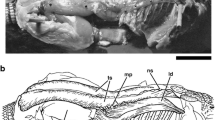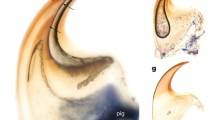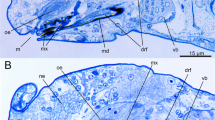Abstract
It is accepted in the literature that the levator veli palatini muscle of artiodactyls originates at the ectotympanic bone, a statement based on macroscopic dissection of adult specimens. The study of 34 histological serial sections of fetal heads of 23 species of artiodactyls revealed that this generalization must be modified: in the studied Camelidae, Suidae, Hippopotamidae, Giraffidae, and in some Bovidae (namely Tragelaphus and Antidorcas) the primary attachment of this functionally important muscle is at the tendinous intersection with the tensor veli palatini. Primary ontogenetic attachments are considered as relevant for defining homologies. By outgroup comparison (Felis and Diceros), this structural connection (character state 1) is also found in the Scrotifera—and hence may be considered as plesiomorphic for the Artiodactyla and its subunits. Only in the Tragulidae, Cervidae, Moschidae, and some Bovidae is a secondary attachment at the ectotympanic observed, which is interpreted as apomorphic for these taxa; possibly this character state 2 developed homoplastically several times. Bovidae show a mixed distribution of this character: Tragelaphus, Aepyceros, and Antidorcas show only a connection of the levator with the tensor veli; in Neotragus, Raphicerus, and Sylvicapra there exists an additional insertion at the ectotympanic; only Bos, Cephalophus, Damaliscus, and Ovis have a primary origin at the ectotympanic. It can be demonstrated in late fetal Sus that a secondary insertion of the levator veli at the ectotympanic is established during ontogeny; in a late fetal Ovis a secondary contact with the tensor veli is realized. The interpretation of this character distribution depends not only on an intrinsic polarity (‘Lesrichtung’), but also on the assumed character state of the groundplan of the common ancestor of the Bovidae. The anatomical observations are documented by photographs of relevant histological sections. The character states are mapped on a simplified and synoptic cladogram of extant artiodactyls; their pattern of evolutionary transformation as well as their relevance for the phylogenetic systematics of this mammalian order are discussed.







Similar content being viewed by others
Abbreviations
- ali:
-
Alisphenoid
- bl:
-
Blastema
- bsph:
-
Basisphenoid
- cM:
-
Cartilage of Meckel
- con:
-
Mandibular condyle
- cphs:
-
Constrictor pharyngis superior
- cty:
-
Tympanic cavity
- den:
-
Dentary
- ecty:
-
Ectotympanic
- fat:
-
Fat tissue
- hpt:
-
Hamulus pterygoideus
- mlv:
-
Levator veli muscle
- mpm:
-
Medial pterygoid muscle
- mtv:
-
Tensor veli muscle
- muv:
-
Uvular muscle
- pal:
-
Pterygoid process of palatine
- pha:
-
Nasopharynx
- ppt:
-
Pterygoid process of alisphenoid
- rph:
-
Recessus pharyngeus
- rphs:
-
Retropharyngeal space
- top:
-
Tonsilla palatina
- tua:
-
Auditory tube
- vel:
-
Velum palatinum (soft palate)
References
Asher RJ, Bennett N, Lehmann T (2009) The new framework for understanding placental mammal evolution. BioEssays 31: 853–864
Barge JAJ (1937) Mundhöhlendach und Gaumen. In: Bolk L, Göppert E, Kallius E, Lubosch W (eds) Handbuch der vergleichenden Anatomie der Wirbeltiere vol. 6: 29–48. Urban and Schwarzenberg, Berlin
Barghusen HR (1986): On the evolutionary origin of the therian tensor veli palatini and tensor tympani muscles. In: Hotton N, MacLean PD, Roth JJ, Roth EC (eds) The Ecology and Biology of Mammal-like Reptiles. Smithsonian Institution Press, Washington DC, pp 253–262
Bärmann EV, Sánchez-Villagra MR (2012) A phylogenetic study of late growth events in a mammalian evolutionary radiation—the cranial sutures of terrestrial artiodactyl mammals. J Mammal Evol 19: 43–56
Braus H, Elze C (1956) Anatomie des Menschen. volume II, Eingeweide. 3rd ed. Springer Verlag, Berlin
Braus H, Elze C. (1960) Anatomie des Menschen. volume III, Nervensystem. 2nd ed., Springer Verlag, Berlin
Crompton AW, German RZ, Thexton AJ (1997) Mechanisms of swallowing and airway protection in infant mammals (Sus domestica and Macaca fascicularis). J Zool Lond 241: 89–102
Edgeworth FH (1935) The Cranial Muscles of Vertebrates. Cambridge University Press, Cambridge
Eschweiler R (1899) Zur vergleichenden Anatomie der Muskeln und der Topographie des Mittelohrs verschiedener Säugethiere. Archiv mikrosk Anat Entw gesch 53: 558–622
Fernandez MH, Vrba ES (2005) A complete estimate of the phylogenetic relationships in Ruminantia: a dated species-level supertree of the extant ruminants. Biol Rev 80: 269–302
Fourie S (1974) The cranial morphology of Thrinaxodon liorhinus Seeley. Ann S Afr Mus 65: 337–400
Gegenbaur C (1874) Grundriß der vergleichenden Anatomie. Engelmann, Leipzig
Gentry AW (1970) The Bovidae (Mammalia) of the Fort Ternan fossil fauna. In: Leakey LSB, Savage RJG (eds) Fossil Vertebrates of Africa, vol. 2. 243–323. Academic Press, London, pp 243–323
Gentry AW (1990) Evolution and dispersal of African Bovidae. In: Bubenik GA, Bubnik BA (eds) Horns, Pronghorns, and Antlers. Springer Verlag, New York, pp 195–227
Gentry AW, Hooker JJ (1988) The phylogeny of the Artiodactyla. In: Benton MJ (ed) The Phylogeny and Classification of the Tetrapods, vol. 2 (Mammals). Clarendon Press, London, pp 235–282
Hall BK, ed (1994) Homology. The Hierarchical Basis of Comparative Biology. Academic Press, London
Hall BK (2005) Bones and Cartilage: Developmental and Evolutionary Skeletal Biology. Elsevier Academic Press, Amsterdam
Hassanin A, Delsuc F, Ropiquet A, Hammer C, VanVuren B, Matthee C, Ruiz-Garcia M, Catzeflis F, Areskoug V, Nguyen TT, Couloux A (2012) Pattern and timing of diversification of Cetartiodactyla (Mammalia, Laurasiatheria), as revealed by a comprehensive analysis of mitochondrial genomes. Comptes Rendus Biol 335, 32–50
Hassanin A, Douzery EJP (2003) Molecular and morphological phylogenies of Ruminantia and the alternative position of the Moschidae. Syst Biol 52: 206–228
Hennig W (1966) Phylognetic Systematics. University of Illinois Press, Urbana
Hennig W (1982) Phylogenetische Systematik. Pareys Studientexte 34, Parey Verlag, Hamburg
Himmelreich HA (1964) Der M. tensor veli palatini der Säugetiere unter Berücksichtigung seines Aufbaus, seiner Funktion und seiner Entstehungsgeschichte. Anat Anz 115: 1–26
Huene Fv (1956) Paläontologie und Phylogenie der Niederen Tetrapoden. Fischer Verlag, Jena
Janis CM (1990) Correlation of reproductive and digestive strategies in the evolution of cranial appendages. In: Bubenik GA, Bubnik AB (eds) Horns, Pronghorns, and Antlers. Springer Verlag, New York, pp 114–133
Janis CM, Scott KM (1987) The interrelationships of higher ruminant families, with special emphasis of the members of the Cervoidea. Am Mus Novitates 2893: 1–85
Janis CM, Scott KM (1988) The phylogeny of the Ruminantia (Artiodactyla, Mammalia). In: Benton MJ (ed) The Phylogeny and Classification of the Tetrapods, vol. 2 (Mammals). Clarendon Press, London, pp 235–282
Kemp TS (1982) Mammal-like Reptiles and the Origin of Mammals. Academic Press, London
Kemp TS (2005) The Origin and Evolution of Mammals. Oxford University Press, Oxford
Langer P (1974) Stomach evolution in the Artiodactyla. Mammalia 38: 295–314
Langer P (2001) Evidence from the digestive tract on the phylogenetic relationships in ungulates and whales. J Zool Syst Evol Res 39: 77–90
Lubosch W (1938) Muskeln des Kopfes: Viscerale Muskulatur. D. Säugetiere. In: Bolk L, Göppert E, Kallius E, Lubosch W (eds) Handbuch der vergleichenden Anatomie der Wirbeltiere, vol. 5. Urban & Schwarzenberg, Berlin, pp 1066–1106
Luckett WP, Hong N (1998) Phylogenetic relationships between orders Artiodactyla and Cetacea: a combined assessment of morphological and molecular evidence. J Mammal Evol 5: 127182
Maier W (1999) On the evolutionary biology of early mammals—with methodological remarks on the interaction between ontogenetic adaptation and phylogenetic transformation. Zool Anz 238: 55–74
Maier W (2008) Epitensoric position of the chorda tympani in Anthropoidea: a new synapomorphic character, with remarks on the fissura Glaseri. In: Sargis EJ, Dagosto M (eds) Mammalian Evolutionary Morphology. A Tribute to Frederick S. Szalay. Springer, Dordrecht, pp 347–360
Maier W, Heever J van den, Durand F (1996) New therapsid specimens and the origin of the secondary hard and soft palate of mammals. J Zool Syst Evol Res 34: 9–19
Marcot JD (2007) Molecular phylogeny of terrestrial artiodactyls. In: Prothero DR, Foss SE (eds) The Evolution of Artiodactyls. The Johns Hopkins University Press, Baltimore, pp 4–18
Matthee CA, Burzlaff JD, Taylor JF, Davis SK (2001) Mining the mammalian genome for artiodactyl systematics. Syst Biol 50: 367–390
Mendrez CH (1975) Principales variations du palais chez les thérocephales sud-africains (Pristerognathus et Scalooposauria) au cours due Permien supérieur et du Trias inférieur. Colloq intern CNRS 218: 379–407
Meredith RW, Janecka JE, Gatesy J, Ryder OA, Fisher CA, Teeling EC, Goodbla A, Eizirik E, Simao TLL, Stadler T, Rabosky DL, Honeycuttt RL, Flynn JJ, Ingram CM, Steiner C, Williams TL, Robinson TJ, Burk-Herrick A, Westerman M, Ayoub NA, Springer MS, Murphy WJ (2011) Impacts of the Cretaceous terrestrial revolution and KPg extinction on mammalian diversification. Science 334: 521–524
Mickoleit G (2004) Phylogenetische Systematik der Wirbeltiere. Verlag Dr. Friedrich Pfeil München
Murphy WJ, Eizirik E, O’Brien SJ, Madsen O, Scally M, Douady CJ, Teeling E, Ryder OA, Stanhope MJ, de Jong WW, Springer MS (2001) Resolution of the early placental mammalian radiation using Bayesian phylogenetics. Science 294: 2348–2351
Nishihara H, Hasegawa M, Okada N (2006) Pegasoferae, an unexpected mammalian clade revealed by tracking ancient retroposon insertions. PNAS 103: 9929–9934
Pauwels F (1960) Eine neue Theorie über den Einfluß mechanischer Reize auf die Differenzierung der Stützgewebe. Z Anat Entwickl gesch 121: 478–515
Price SA, Bininda-Emonds ORP, Gittleman JL. (2005) A complete phylogeny of the whales, dolphins and even-toed hoofed mammals (Cetartiodactyla). Biol Rev 80, 445–473
Ruf I, Frahnert S, Maier W (2009) The chorda tympani and its significance for rodent phylogeny. Mammal Biol 74, 100–113
Saban R (1968) Musculature de la tête. In: Grassé P-P (ed) Traité de Zoologie, vol 16, fasc. 2, (Mammifères, Musculature). Masson, Paris, pp 229–472
Springer MS, Murphy WJ, Eizirik E, O’Brien SJ (2003) Placental mammal diversification and the Cretaceous–Tertiary boundary. PNAS 100: 1056–1061
Starck D (1967) Le crâne des Mammifères. In: Grassé P-P (ed) Traité de Zoologie, vol. 16, fasc.1. Masson, Paris, pp 405–549
Starck D (1979) Vergleichende Anatomie der Wirbeltiere. Vol. 2: Das Skeletsystem. Springer, Stuttgart
Starck D (1995) Lehrbuch der Speziellen Zoologie.vol. II, Teil 5/1 und 5/2, Säugetiere. Fischer, Jena
Theodor JM, Rose KD, Erfurt J (2005) Artiodactyla. In: Rose KD, Archibald JD (eds) The Rise of Placental Mammals. Johns Hopkins University Press, Baltimore, pp 215–233
van Kampen PN (1905) Die Tympanalgegend des Säugetierschädels. Morph Jahrb 34: 321–722
von Kostanecky E (1891) Zur Morphologie der Tubengaumenmuskulatur. Arch Anat Entw gesch 1891: 145–181
Warwick R, Williams PL (1973) Gray’s Anatomy. 35th ed. Longmans, London
Weber M (1927/28) Die Säugetiere. Einführung in die Anatomie und Systematik der recenten und fossilen Mammalia. 2nd ed. Volumes 1 and 2. Fischer, Jena
Werdelin L, Sanders WJ, eds (2010) Cenozoic Mammals of Africa. University of California Press, Berkeley
Wood Jones F (1940) The nature of the soft palate. J Anat 74:147–170
Acknowledgements
The heads of 23 species of artiodactyl fetuses have been accumulated over the last 25 years or so; they have all been prepared in the histology labs of either the Dr. Senckenbergische Anatomie, Frankfurt/Main, or at the Department of Systematic Zoology of the University of Tübingen, where they are presently housed. I thank the technical assistants, who prepared the serial sections with great skill and patience: Monika Meinert, Thi Thi Fussnegger, Christina Nitzsche. A number of institutions have loaned specimens for histological processing: the American Museum of Natural History, New York; the Naturkundemuseum Berlin; the Museum of Zoology, Hamburg; and Department of Zoology, University of Stellenbosch. Some specimens were personal gifts by the late Prof. Dietrich Starck, to whose memory this study is dedicated.
Author information
Authors and Affiliations
Corresponding author
Rights and permissions
About this article
Cite this article
Maier, W. The Levator Veli Palatini Muscle in Artiodactyls—A Comparative Ontogenetic Study. J Mammal Evol 20, 199–212 (2013). https://doi.org/10.1007/s10914-012-9210-5
Published:
Issue Date:
DOI: https://doi.org/10.1007/s10914-012-9210-5




